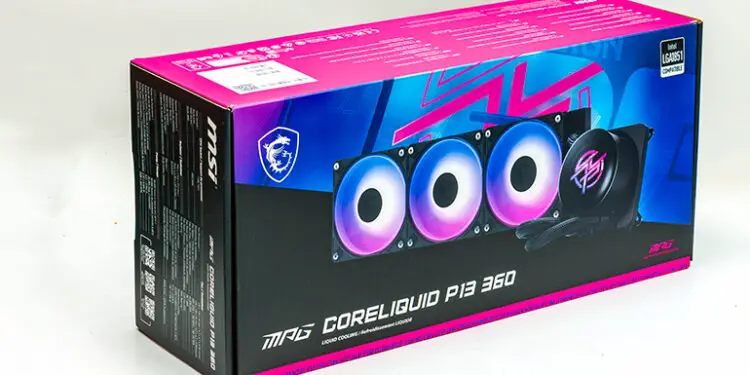
Segueing into the tubing itself, we take basically no issue with what MSI’s design team has opted for. EPDM (Ethylene Propylene Diene Monomer) is not fancy, but it is both flexible and efficient. Sure over time a tiny bit more air will “leak” into it than some other types of ‘rubber’. Sure, MSI could/should have gone with a bigger ID (its probably in the 6 to 8mm range). But EPDM is the industry standard for a reason… as it is just that good in its compromises between all the various other options.

Mix in a decently generous tubing length of (~37cm to) ~39cm (depending on how you measure the length), and MSI got this portion of the P13 right.

Before we get to the obvious star of the show, let us first circle back to that rad.

On first glance, the radiatorof the P13 pretty much looks like your bog-standard ‘thin’ 3×120 radiator. Sure, it is rocking a gorgeous paint job that is thick, scratch-resistant, and a deep black… but that is not all that unusual.

The same is true for the specifications. ~393 mm long. 27mm ‘tall’. Approximately 20 folds per inch. All pretty much standard fare for the AIO market. However, when you pay close attention to the inlet/outlet port area one thing does standard out: a side/i> mounted fill port. Sure, it is sealed and has a warranty void covering it… But it is there.

This feature is highly interesting. We say this as it is blatantly obvious that the P13 is not using an off-the-shelf Asetek ‘thin’ radiator. Nor is it using an off-the-shelf Cooler Master or Apaltek ‘thin’ radiator. Not even a CoolIT rad matches this rad. With the most common AIO OEM/ODMs eliminated, many will be scratching their heads, as not many others include an obvious fill port. Some of the (less than a) handful left (/cough AlphaCool, Koolance… actual WC manufactures /cough) place it at the other end on their custom water loop rads… and very, very few place it on the side near the inlet/outlet ports and then ‘seal’ it with a Philips head bolt. In fact… that pretty much narrows it down to one company: KD Industrial. A company that may not be as well known on this side of the pond… but when companies like Be Quiet! (e.g., Silent Loop 3, whose rad is pretty much a dead ringer for the P13’s) Tap them as their ODM of choice; you know they have the experience and abilities to do it right.

Moving on. Tracing those gorgeous tubes to their other end, we come to the main attraction. The custom waterblock+ pump combination unit… and boy did MSI pack a lot of features into this moderately sized unit. The first is obvious: the LCD screen covering the entire top of the block. Yes, including a screen is not unusual, as many have done it. A 2.1-inch IPS LCD panel with a resolution of 480×480 pixels and brightness up to 600 nits is unusual.

Put simply, this LCD screen does what few can do: deliver on a promise of offering vibrant and customizable visuals. In addition to the usual abilities of displaying CPU temp or load, or use custom GIF animations for visual flair… if one so chooses, you can even ‘extend’ your system’s main monitor onto it via the free MSI software. Mix in the fact that MSI wisely enclosed this small LCD screen in a clear, curved “gorilla glass” covering, and it is as obvious as who the ODM is that MSI has succeeded here where many others have failed. They have succeeded because… It. Just. Works. It is easily customizable. It easily enhances any build’s final aesthetics. Better still, if we drop a screw (or screwdriver) and that Mr. Murphy Missile hits the screen, we won’t cry… because MSI armored it (and curved it) against such iterant issues. Color us highly impressed.

Make no mistake, this eye-catching hardware+software feature is actually the least of what MSI has baked into this new ‘block. While it is technically correct that the inlet and outlet ports connected to the tubing are located on one side of this… rounded corner rectangular block, the fact of the matter is that looks can indeed be deceiving. Simply stated, this block uses what MSI is calling a “CenterFlow” design. One where the inlet and outlets may be on the side, and the inlet may flow into the pump more towards the side… but the coolant entering the copper microfin cooling array does not enter from one side. Nor do the coolant entering and exiting even coexist on the same plane.

Basically, instead of the coolant entering at one end of the fin array and then exiting the other, with this new MSI design it is sucked into the pump’s inlet on the middle layer of the block (the top most is for the controller and then LCD) and pushed down to the center of the bottom layer… where it is then forced laterally outwards. In all directions. At the same time. Until it hits the edges and is then, and only then, routed to the edge with the outlet port (and is then pushed up the tubing and into the rad where it starts its journey all over again). Needless to say, this does require a radically different microfin array layout design, but by the coolest liquid entering right over the typical hotspot on CPUs… CPU temperatures can more efficiently be kept in check than if it hits the edge, cools the secondary chiplets first, and then and only then cools the ‘CPU’ cores. Equally important as the coolant is not flowing back over itself (like it can in typical microfin arrays), coolant mixing is negligible, backpressure is lower than most, and coolant velocity is kept much more consistent than older designs (and most blocks on the market for that matter).

As an added bonus, since this CenterFlow design keeps turbulence to a minimum, the number one cause of “pump noise” is also minimized. This all translates into a rather mild-mannered pump that can outperform bigger/noisier pump designs even at lower RPMS. With that said, all these small pumps used in AIOs should run at the higher end of their range to reduce pump strain. As we have said in the past, back pressure / static pressure is what puts the most strain on a pump, and if you do not keep the numbers up above this silent mandatory minimum… You will significantly reduce the pump’s lifespan. Thankfully, the CoreLiquid P13 does have more freedom than most in this regard, so it should easily exceed its 50 K-rated lifespan even if you don’t put much thought into its speed profile. Heck. Hard set it at anything above, say, 75 percent,and it should live well past its rated lifespan.

Also yes. You are going to hear the pump at its full 3.4K RPM. With that said. It is not what we would classify as a ‘loud’ pump. Rather, this pumps noise profile edges more towards the lower frequency hum/wooshing/whirring end of things, rather higher frequency/pitch ‘screams’. If, for whatever reason, you are more sensitive to low frequency rather than high frequency noise profiles, we can report that at it is inaudible in the low 2K RPM range, so this advanced pump can pay dividends in both sheer cooling performance and noise to cooling performance. It just depends on what matters most to you.

Overall, it is pretty easy to tell that the P13 design team spent their budget wisely. So while this is certainly a premium-priced AIO… it actually lives up to expectations in what it offers… or at least on paper and first blush it does. Let’s install this bad boy and see if that new mounting hardware is as good as it looks.









